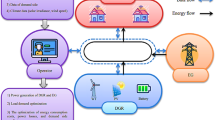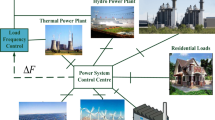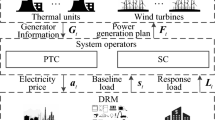Abstract
The main work of this paper is to describe the influence of transmission line modeling routine in ORPD and ELD problems by using the minimized sum of the squares of normal deviates ant lion optimization algorithm. This method applied on proposed IEEE 57 bus power systems in an effort to achieve the best performance with stable and secure operation of all systems. The proposed method in this paper has improved standard ant lion optimizer (ALO) in terms of both exploration and exploitation properties.The proposed LR-ALO method was applied to solve four versions of power system models, such as positive sequence, 3-Phase PI, and CP transmission lines based power systems, and also lumped PI lines based low voltage hardware model of power system. The effectiveness of proposed method on all power systems were used to determine the generator voltage, tap position of transformers, and reactive power injection subjected to power loss minimization in ORPD problem. Also, calculated voltage deviation, voltage stability index for propsed systems. Similarly, optimal allocation of active power generation among all generators in the system found to balance both load demand and losses subjected to minimization of total fuel cost of the power system in ELD problem. A comprehensive analysis of optimization results was shown that the possible solutions of control variables in both ORPD and ELD problems. Also, the comparison of results was shown the accuracy and effectiveness of proposed method over elitism phases of ALO and other meta heuristic algorithms.




Similar content being viewed by others
References
Zhao X, Zhou H, Shi D, Zhao H, Jing C, Jones C (2015) On-line pmu-based transmission line parameter identification. CSEE J Power Energy Syst 1:68–74
Asprou M, Kyriakides E (2015) Estimation of transmission line parameters using pmu measurements. In: IEEE power and energy society general meeting, IEEE, pp. 1–5
Peralta JA, De Leon F, Mahseredjian J (2008) Unbalanced multiphase load-flow using a positive-sequence load-flow program. IEEE Trans Power Syst 23:469–476
Koksal M, Mehmet SM (2000) Remark on the lumped parameter modeling of transmission lines. Electric Mach Power Syst 28:565–575
Liao Y (2009) Equivalent pi circuit for zero-sequence networks of parallel transmission lines. Electric Power Component Syst 37:787–797
Abido M, Bakhashwain J (2005) Optimal var dispatch using a multiobjective evolutionary algorithm. Int J Electr Power Energy Syst 27:13–20
Khorsandi A, Hosseinian S, Ghazanfari A (2013) Modified artificial bee colony algorithm based on fuzzy multi-objective technique for optimal power flow problem. Electric Power Syst Res 95:206–213
Wood AJ, Wollenberg BF, Sheblé GB (2013) Power generation, operation, and control. Wiley, New York
Lee K, Park Y, Ortiz J (1985) A united approach to optimal real and reactive power dispatch. IEEE Trans Power Apparatus Syst 1147–1153
Sinha N, Chakrabarti R, Chattopadhyay P (2003) Evolutionary programming techniques for economic load dispatch. IEEE Trans Evol Comput 7:83–94
Abido MA (2006) Multiobjective evolutionary algorithms for electric power dispatch problem. IEEE Trans Evol Comput 10:315–329
Jabr RA, Coonick AH, Cory BJ (2000) A homogeneous linear programming algorithm for the security constrained economic dispatch problem. IEEE Trans Power Syst 15:930–936
Lai L, Nieh T, Vujatovic D, Ma Y, Lu Y, Yang Y, Braun H (2005) Swarm intelligence for optimal reactive power dispatch. In: IEEE/PES transmission and distribution conference and exposition: Asia and Pacific, IEEE, pp 1–5
Grudinin N (1998) Reactive power optimization using successive quadratic programming method. IEEE Trans Power Syst 13:1219–1225
Liang Z-X, Glover JD (1992) A zoom feature for a dynamic programming solution to economic dispatch including transmission losses. IEEE Trans Power Syst 7:544–550
Granville S (1994) Optimal reactive dispatch through interior point methods. IEEE Trans Power Syst 9:136–146
Wu Z, Ding J, Wu Q, Jing Z, Zhou X (2016) Two-phase mixed integer programming for non-convex economic dispatch problem with spinning reserve constraints. Electric Power Syst Res 140:653–662
Bjelogrlic M, Calovic MS, Ristanovic P, Babic BS (1990) Application of newton’s optimal power flow in voltage/reactive power control. IEEE Trans Power Syst 5:1447–1454
Bonabeau E, Marco DDRDF, Dorigo M, Théraulaz G, Theraulaz G et al., (1999) Swarm intelligence: from natural to artificial systems. 1, Oxford University Press, Oxford
Walters DC, Sheble GB (1993) Genetic algorithm solution of economic dispatch with valve point loading. IEEE Trans Power Syst 8:1325–1332
James J, Li VO (2016) A social spider algorithm for solving the non-convex economic load dispatch problem. Neurocomputing 171:955–965
Basu M, Chowdhury A (2013) Cuckoo search algorithm for economic dispatch. Energy 60:99–108
Pothiya S, Ngamroo I, Kongprawechnon W (2010) Ant colony optimisation for economic dispatch problem with non-smooth cost functions. Int J Electr Power Energy Syst 32:478–487
Noman N, Iba H (2008) Differential evolution for economic load dispatch problems. Electric Power Syst Res 78:1322–1331
Al-Betar MA, Awadallah MA, Khader AT, Bolaji AL, Almomani A (2018) Economic load dispatch problems with valve-point loading using natural updated harmony search. Neural Comput Appl 29:767–781
Gaing Z-L (2003) Particle swarm optimization to solving the economic dispatch considering the generator constraints. IEEE Trans Power Syst 18:1187–1195
Mohammadi-Ivatloo B, Rabiee A, Soroudi A, Ehsan M (2012) Imperialist competitive algorithm for solving non-convex dynamic economic power dispatch. Energy 44:228–240
Sonmez Y, Kahraman HT, Dosoglu MK, Guvenc U, Duman S (2017) Symbiotic organisms search algorithm for dynamic economic dispatch with valve-point effects. J Exp Theoret Artif Intell 29:495–515
Hemamalini S, Simon SP (2010) Artificial bee colony algorithm for economic load dispatch problem with non-smooth cost functions. Electric Power Components Syst 38:786–803
Duman S, Güvenç U, Yörükeren N (2010) Gravitational search algorithm for economic dispatch with valve-point effects. Int Rev Electric Eng 5:2890–2895
Yang X-S, Hosseini SSS, Gandomi AH (2012) Firefly algorithm for solving non-convex economic dispatch problems with valve loading effect. Appl Soft Comput 12:1180–1186
Wulandhari LA, Komsiyah S, Wicaksono W (2018) Bat algorithm implementation on economic dispatch optimization problem. Procedia Comput Sci 135:275–282
Yoshida H, Kawata K, Fukuyama Y, Takayama S, Nakanishi Y (2000) A particle swarm optimization for reactive power and voltage control considering voltage security assessment. IEEE Trans Power Syst 15:1232–1239
Li Y, Cao Y, Liu Z, Liu Y, Jiang Q (2009) Dynamic optimal reactive power dispatch based on parallel particle swarm optimization algorithm. Comput Math Appl 57:1835–1842
Dai C, Chen W, Zhu Y, Zhang X (2009) Reactive power dispatch considering voltage stability with seeker optimization algorithm. Electric Power Syst Res 79:1462–1471
Rajan A, Malakar T (2015) Optimal reactive power dispatch using hybrid nelder-mead simplex based firefly algorithm. Int J Electric Power Energy Syst 66:9–24
Ghasemi A, Valipour K, Tohidi A (2014) Multi objective optimal reactive power dispatch using a new multi objective strategy. Int J Electric Power Energy Syst 57:318–334
Ghasemi A (2013) A fuzzified multi objective interactive honey bee mating optimization for environmental/economic power dispatch with valve point effect. Int J Electric Power Energy Syst 49:308–321
Sulaiman MH, Mustaffa Z, Mohamed MR, Aliman O (2015) Using the gray wolf optimizer for solving optimal reactive power dispatch problem. Appl Soft Comput 32:286–292
Bhattacharya A, Chattopadhyay P (2011) Application of biogeography-based optimisation to solve different optimal power flow problems. IET Gen Transm Distrib 5:70–80
Bouchekara H (2014) Optimal power flow using black-hole-based optimization approach. Appl Soft Comput 24:879–888
Dai C, Chen W, Zhu Y, Zhang X (2009) Seeker optimization algorithm for optimal reactive power dispatch. IEEE Trans Power Syst 24:1218–1231
Ramirez JM, Gonzalez JM, Ruben TO (2011) An investigation about the impact of the optimal reactive power dispatch solved by de. Int J Electric Power Energy Syst 33:236–244
Mandal B, Roy PK (2013) Optimal reactive power dispatch using quasi-oppositional teaching learning based optimization. Int J Electric Power Energy Syst 53:123–134
Rajan A, Malakar T (2016) Exchange market algorithm based optimum reactive power dispatch. Appl Soft Comput 43:320–336
Duman S, Sönmez Y, Güvenç U, Yörükeren N (2012) Optimal reactive power dispatch using a gravitational search algorithm. IET Gen Transm Distrib 6:563–576
Sen T, Mathur HD (2016) A new approach to solve economic dispatch problem using a hybrid aco-abc-hs optimization algorithm. Int J Electric Power Energy Syst 78:735–744
Barati H, Sadeghi M (2018) An efficient hybrid mpso-ga algorithm for solving non-smooth/non-convex economic dispatch problem with practical constraints. Ain Shams Eng J 9:1279–1287
Morshed MJ, Asgharpour A (2014) Hybrid imperialist competitive-sequential quadratic programming (hic-sqp) algorithm for solving economic load dispatch with incorporating stochastic wind power: a comparative study on heuristic optimization techniques. Energy Convers Manage 84:30–40
Kamboj VK, Bhadoria A, Bath S (2017) Solution of non-convex economic load dispatch problem for small-scale power systems using ant lion optimizer. Neural Comput Appl 28:2181–2192
Trivedi IN, Jangir P, Parmar SA (2016) Optimal power flow with enhancement of voltage stability and reduction of power loss using ant-lion optimizer. Cogent Eng 3:1208942
Dubey HM, Pandit M, Panigrahi B (2016) Ant lion optimization for short-term wind integrated hydrothermal power generation scheduling. Int J Electric Power Energy Syst 83:158–174
Kumar S, Kumar A (2018) A brief review on antlion optimization algorithm. In: International conference on advances in computing, communication control and networking (ICACCCN), IEEE, pp 236–240
Ali E, Abd Elazim S, Abdelaziz A (2018) Optimal allocation and sizing of renewable distributed generation using ant lion optimization algorithm. Electrical Eng 100:99–109
Mirjalili S (2015) The ant lion optimizer. Adv Eng Softw 83:80–98
Assiri AS, Hussien AG, Amin M (2020) Ant lion optimization: variants, hybrids, and applications. IEEE Access 8:77746–77764
Christie R (2000) Power systems test case archive. University of Washington, Electrical Engineering Department, Washington, DC, p 108
Natarajan R. Computer-aided power system analysis, Boca Raton, Florida
Saremi S, Mirjalili S, Lewis A (2017) Grasshopper optimisation algorithm: theory and application. Adv Eng Softw 105:30–47
Mirjalili S, Lewis A (2016) The whale optimization algorithm. Adv Eng Softw 95:51–67
Bansal JC, Sharma H, Jadon SS, Clerc M (2014) Spider monkey optimization algorithm for numerical optimization. Memetic Comput 6:31–47
Rajan A, Jeevan K, Malakar T (2017) Weighted elitism based ant lion optimizer to solve optimum var planning problem. Appl Soft Comput 55:352–370
Wijeweera G, Annakkage UD, Zhang W, Rajapakse AD (2016) Derivation of an equivalent circuit for real-time security assessment. IET Gen Transm Distrib 10:1913–1920
Wijeweera G, Annakkage UD, Zhang W, Rajapakse AD, Rheault M (2017) Development of an equivalent circuit of a large power system for real-time security assessment. IEEE Trans Power Syst 33:3490–3499
Gasbaoui B, Allaoua B (2009) Ant colony optimization applied on combinatorial problem for optimal power flow solution. Leonardo J Sci 14:1–17
Lin W-M, Cheng F-S, Tsay M-T (2002) An improved tabu search for economic dispatch with multiple minima. IEEE Trans Power Syst 17:108–112
Shilaja C, Arunprasath T, Priya P (2019) Day-ahead optimal scheduling of microgrid with adaptive grasshopper optimization algorithm. Int J Commun Syst
Niknam T, Golestaneh F (2012) Enhanced bee swarm optimization algorithm for dynamic economic dispatch. IEEE Syst J 7:754–762
Caballero PT, Costa ECM, Kurokawa S (2017) Modal decoupling of overhead transmission lines using real and constant matrices: influence of the line length. Int J Electric Power Energy Syst 92:202–211
Caballero PT, Costa ECM, Kurokawa S (2015) Frequency-dependent multiconductor line model based on the bergeron method. Electric Power Syst Res 127:314–322
Acknowledgements
The data used in this paper for hardware analysis was obtained from the DST-SERB EMEQ sponsored project named as “Hardware model implementation of IEEE 57 bus power system network”. Thankful to the DST-SERB and Vignan’s Foundation for Science, Technology & Research.
Author information
Authors and Affiliations
Corresponding author
Additional information
Publisher's Note
Springer Nature remains neutral with regard to jurisdictional claims in published maps and institutional affiliations.
Rights and permissions
Springer Nature or its licensor (e.g. a society or other partner) holds exclusive rights to this article under a publishing agreement with the author(s) or other rightsholder(s); author self-archiving of the accepted manuscript version of this article is solely governed by the terms of such publishing agreement and applicable law.
About this article
Cite this article
Chary, G.V.B., Rosalina, K.M. Least Squares Regression Based Ant Lion Optimizer to Solve Optimal Reactive Power and Economic Load Dispatch Problems. J. Electr. Eng. Technol. 18, 3391–3413 (2023). https://doi.org/10.1007/s42835-023-01412-3
Received:
Revised:
Accepted:
Published:
Issue Date:
DOI: https://doi.org/10.1007/s42835-023-01412-3




